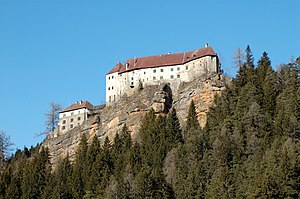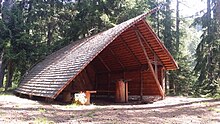Rothenfels Castle (Oberwölz)
| Rothenfels Castle | ||
|---|---|---|
|
View of the castle |
||
| Creation time : | approx. 800 AD first mentioned 1007 AD | |
| Castle type : | Höhenburg, rocky location | |
| Conservation status: | very well preserved | |
| Construction: | Well-fortified architectural style | |
| Geographical location | 47 ° 12 '0.3 " N , 14 ° 17' 36.4" E | |
|
|
||
The castle Rothenfels (also known as Castle Rock Roth called) is a medieval rock castle east of Oberwölz in Styria in Austria.
overview
Rothenfels Castle is one of the few medieval castles that have retained their original appearance to this day. The whole area of Oberwölz was originally the chamber property of the German kings. The Wölzertal with its secret diversity was owned by the Hochstift Freising from 1007 to 1803 . The Mohr in the coat of arms of the city of Oberwölz and the castle also comes from the diocese of Freising. Rothenfels Castle was the seat of jurisdiction for the entire Wölzertal, Katsch, St. Peter am Kammersberg and for Lind bei Scheifling.
history
Oberwölz in Styria in Austria .
The castle is located on an iron-bearing reddish rock east about 100 meters above the town of Oberwölz .
Gut Welz and Gut Lind were given to the Bishop of Freising (Egilbert) on May 10, 1007 by King Heinrich II . To commemorate this donation, the Rowanda Hut was built in 2007 in a forest near Rothenfels Castle ( Ro thenfelser W ald Anda cht).
As the center of administration, the castle was probably built by the diocese , initially just a tower to which the residential and farm buildings were attached. The bishop appointed burgraves , probably from the Freising families, who called themselves von Welz, the first documented being Heinrich 1140. The name Rothenfels only later replaced the name Welz for the castle. The Welzer occupied a respected position in the country. The Welzer, who sat for over 300 years as bishop-freising administrators on Rothenfels, had mixed up with the Teufenbachers, the Saurauers and other Styrian families and had held various offices in the country since the 13th century. From the 14th century, burgraves from other sexes sat on Rothenfels.
Around the middle of the 14th century, Rothenfels Castle was expanded, the Katharinenkapelle next to the gate was expanded and goods were provided. According to the Freising Chronicle, significant funds were spent on these buildings, which unfortunately are not described in detail.
In 1413, the Bishop of Freising awarded Rothenfels Castle to Reinprecht von Walsee , the opponent of Prince Duke Ernst . Niklas Baumkircher was appointed burgrave by him. Hans von Stubenberg , a supporter of the duke, attacked Rothenfels, drove Baumkircher from the castle and appointed Hermann Waldner as burgrave. Because of the regional court, Hermann Waldner got into a dispute with the Liechtensteiners on Murau, which the governor Count Haug von Montfort settled in 1415: Reinprecht von Walsee received Rothenfels back in 1418.
In 1419 Hans von Teufenbach was captain of the Rothenfels rule . From 1425, administrators were again appointed to Rothenfels by the Bishop of Freising. Under their administration, in 1476, when the Turkish tax was being collected, there was a battle with the peasants who refused to pay taxes, in which a farmer was killed. In 1480 the Hungarians and at the same time the imperial troops came to Oberwölz under field captain Georg Wolfersdorf, the imperial field captain demanded the opening of the city gates. Hans Welzer, the administrator of the town and castle, was not intimidated, and Hungarians and imperial people had to leave without having achieved anything. The bishop approved of this decision.
In 1490 Sigmund Welzer took over the administration of Rothenfels alone. The subjects of the rule were resident in 14 offices; The "Caplanay im gschloss Rothenfels" (these were peasant subjects whose services were used to maintain a priest at the chapel) formed a separate office. In 1585 there were three Protestant clergymen and two Protestant schoolmasters in the small town of Oberwölz. They were expelled, but the installed Catholic priest was attacked and driven out by the farmers in 1590. Only in the years 1599 and 1600 was it possible to reintroduce Catholic teaching in Oberwölz by force of arms.
In 1604, as a result of the poor management of the business by the administrator Christof Römer, the Rothenfels rule resulted in such large tax outstanding debts that the seizure could only be prevented at the last moment. Only his successors were able to put the administration back in order. The economic difficulties that arose as a result of the Thirty Years' War led to the pledge of Rothenfels to Martin Jocher in 1632, followed by Carl in 1640 and Adam Jocher in 1648 in pledge ownership. The rulers had fishing rights on the Schöttlbach and on the Malleisen lake in the Wölzer Tauern .
In 1656, the Bishop of Freising von Wolf the Elder, Mr. von Stubenberg, acquired the regional court belonging to the Frauenburg dominion, which he linked to the Rothenfels dominion and thus ended centuries of disputes that had flared up again and again.
After the death of the last pledge holder Adam Jocher, the rule fell back to the diocese, which now appointed captains . At that time, the "square Rothenfels Castle" was protected from the west, north and east by triple circular walls. A ditch ran around the curtain wall, and in the south the castle was protected by a rock wall.
After the ecclesiastical rule was abolished in 1803, Rothenfels came to the state and was bought by Eduard Triegler in a public auction for 20,200 guilders in 1823. This was followed by Jakob Boden, Gustav Mayerhoffer and Wenzel Mayerhoffer, in 1893 the timber merchant Morasutti. The latter's heirs sold the castle to the Johann Weinzinger junior company. in Vienna.
In 1965, when the company was liquidated, it was taken over by partner Maria Steiner. Since then, Rothenfels Castle has been privately owned by the Steiner family from the income of the associated forestry business.
description
The imposing and widely visible castle complex is located on the steeply sloping rock east of the town of Oberwölz and was probably built as a fortification at the end of the 12th century; it is documented in 1305. The name Rothenfels refers to the reddish colored castle rock, the original name was Wölz.
The castle slopes gently towards the north and steeply towards the south. It is divided into a higher main castle and an outer castle. In the southeast corner, parts of the medieval main castle are still preserved, which comprised a southern residential wing adapted to the rocky terrain and in the eastern corner a mighty fortified tower; This building core was expanded further to the west, depending on the terrain, and an inner courtyard with wall fencing was connected to the north one floor below. At the northeast corner is a building that is now used as a residential wing and has a late medieval core.
There is a rectangular water basin in the courtyard. Recently, a Gothic pointed arch portal with beveled stone walls was uncovered on the south wall of the courtyard on the second floor. The castle chapel is located in the south-west of the complex, in the west a further building wing was added as a conclusion in the 17th century. Sloping towards the north is the forecourt of the complex, and to the northeast is the medieval gate tower that can be reached via a bridge. Additions in the historicizing style of the 19th century concern, among other things, the surrounding wall, which was provided with battlements.
The castle chapel in the southwest corner on the first floor has a single bay , with a 5/8 end , the ribs have been chipped off. The ceiling painting Saint Catherine of Alexandria with the attribute cartwheel in a scene with philosophers was exposed in 2005 and restored under the direction of restorer Barbara Obermayr. Also to be emphasized are the painted crosses of the apostles, a pointed lava niche with a bulge profile and the late Gothic iron-studded entrance door to the chapel room. The south-west facing court room on the second floor is a corner room with a remarkable stucco ceiling from the 18th century. It is divided into fields, the middle ceiling field adorns a secco painting of a hunting scene, "Diana with honoring knights", dated 1725. Two large archive boxes from the 17th and 18th are closely related to the jurisdiction. Century. The individual archive shops have historically interesting painted inscriptions that provide information about the original content. In the so-called knight's hall below, armor and wall paneling in neo-Gothic forms have been preserved. The remaining rooms were partially adapted for residential purposes and mostly renovated in a historicizing style. Fixed details such as windows, doors, wooden floors and tiled stoves are predominantly from the construction phases of the 17th – 19th centuries. Century. They document the established appearance of the system.
The chapel dedicated to St. Catherine from the 14th century (the late Gothic statue of the Virgin Mary has been a listed building since 1957) and the so-called “court room” on the upper floor with a remarkable stucco ceiling from the 18th century should be emphasized from the various construction periods. It is of particular historical documentation value for the time when the castle served as the official seat of an extensive regional court for almost two centuries between 1656 and 1848. The historically interesting archive cabinets also bear witness to this, and their shop labels indicate the originally large size of the Rothenfels archive.
Additions from the 17th and 18th centuries as well as additions in the historicizing style of the 19th century document the modern tradition of the complex and its evolved appearance.
literature
- Walter Brunner : "Uueliza" - Wölz. History of the cultural landscape and the people in the area of the Oberwölz-Umgebung community. Oberwölz area 2009.
- Austrian art topography, The art monuments of the judicial district of Oberwölz, Vol. 39, Vienna 1973, pp. 156–163.
- Tippl Johann, Oberwölz Pictures from the past of the city and its surroundings, Graz 1868, pp. 137–143.
Web links
- Private website of the owner of Rothenfels Castle
- Entry via Rothenfels Castle (Oberwölz) to Burgen-Austria



